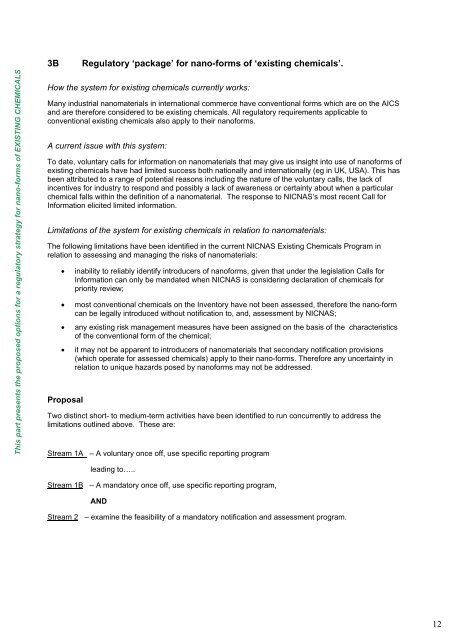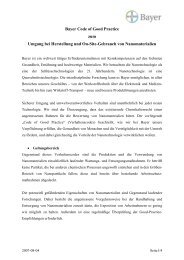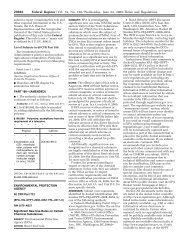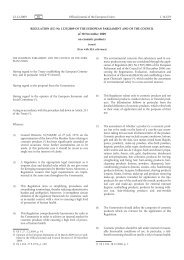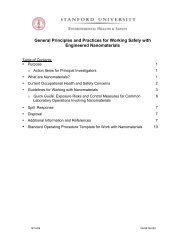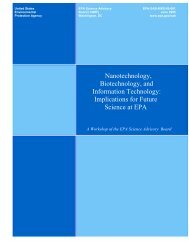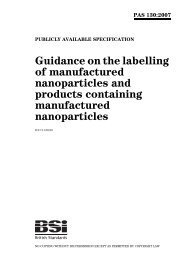Proposal for Regulatory Reform of Industrial Nanomaterials
Proposal for Regulatory Reform of Industrial Nanomaterials
Proposal for Regulatory Reform of Industrial Nanomaterials
You also want an ePaper? Increase the reach of your titles
YUMPU automatically turns print PDFs into web optimized ePapers that Google loves.
This part presents the proposed options <strong>for</strong> a regulatory strategy <strong>for</strong> nano-<strong>for</strong>ms <strong>of</strong> EXISTING CHEMICALS3B<strong>Regulatory</strong> ‘package’ <strong>for</strong> nano-<strong>for</strong>ms <strong>of</strong> ‘existing chemicals’.How the system <strong>for</strong> existing chemicals currently works:Many industrial nanomaterials in international commerce have conventional <strong>for</strong>ms which are on the AICSand are there<strong>for</strong>e considered to be existing chemicals. All regulatory requirements applicable toconventional existing chemicals also apply to their nano<strong>for</strong>ms.A current issue with this system:To date, voluntary calls <strong>for</strong> in<strong>for</strong>mation on nanomaterials that may give us insight into use <strong>of</strong> nano<strong>for</strong>ms <strong>of</strong>existing chemicals have had limited success both nationally and internationally (eg in UK, USA). This hasbeen attributed to a range <strong>of</strong> potential reasons including the nature <strong>of</strong> the voluntary calls, the lack <strong>of</strong>incentives <strong>for</strong> industry to respond and possibly a lack <strong>of</strong> awareness or certainty about when a particularchemical falls within the definition <strong>of</strong> a nanomaterial. The response to NICNAS’s most recent Call <strong>for</strong>In<strong>for</strong>mation elicited limited in<strong>for</strong>mation.Limitations <strong>of</strong> the system <strong>for</strong> existing chemicals in relation to nanomaterials:The following limitations have been identified in the current NICNAS Existing Chemicals Program inrelation to assessing and managing the risks <strong>of</strong> nanomaterials:• inability to reliably identify introducers <strong>of</strong> nano<strong>for</strong>ms, given that under the legislation Calls <strong>for</strong>In<strong>for</strong>mation can only be mandated when NICNAS is considering declaration <strong>of</strong> chemicals <strong>for</strong>priority review;• most conventional chemicals on the Inventory have not been assessed, there<strong>for</strong>e the nano-<strong>for</strong>mcan be legally introduced without notification to, and, assessment by NICNAS;• any existing risk management measures have been assigned on the basis <strong>of</strong> the characteristics<strong>of</strong> the conventional <strong>for</strong>m <strong>of</strong> the chemical;• it may not be apparent to introducers <strong>of</strong> nanomaterials that secondary notification provisions(which operate <strong>for</strong> assessed chemicals) apply to their nano-<strong>for</strong>ms. There<strong>for</strong>e any uncertainty inrelation to unique hazards posed by nano<strong>for</strong>ms may not be addressed.<strong>Proposal</strong>Two distinct short- to medium-term activities have been identified to run concurrently to address thelimitations outlined above. These are:Stream 1A – A voluntary once <strong>of</strong>f, use specific reporting programleading to…..Stream 1B – A mandatory once <strong>of</strong>f, use specific reporting program,ANDStream 2 – examine the feasibility <strong>of</strong> a mandatory notification and assessment program.12


